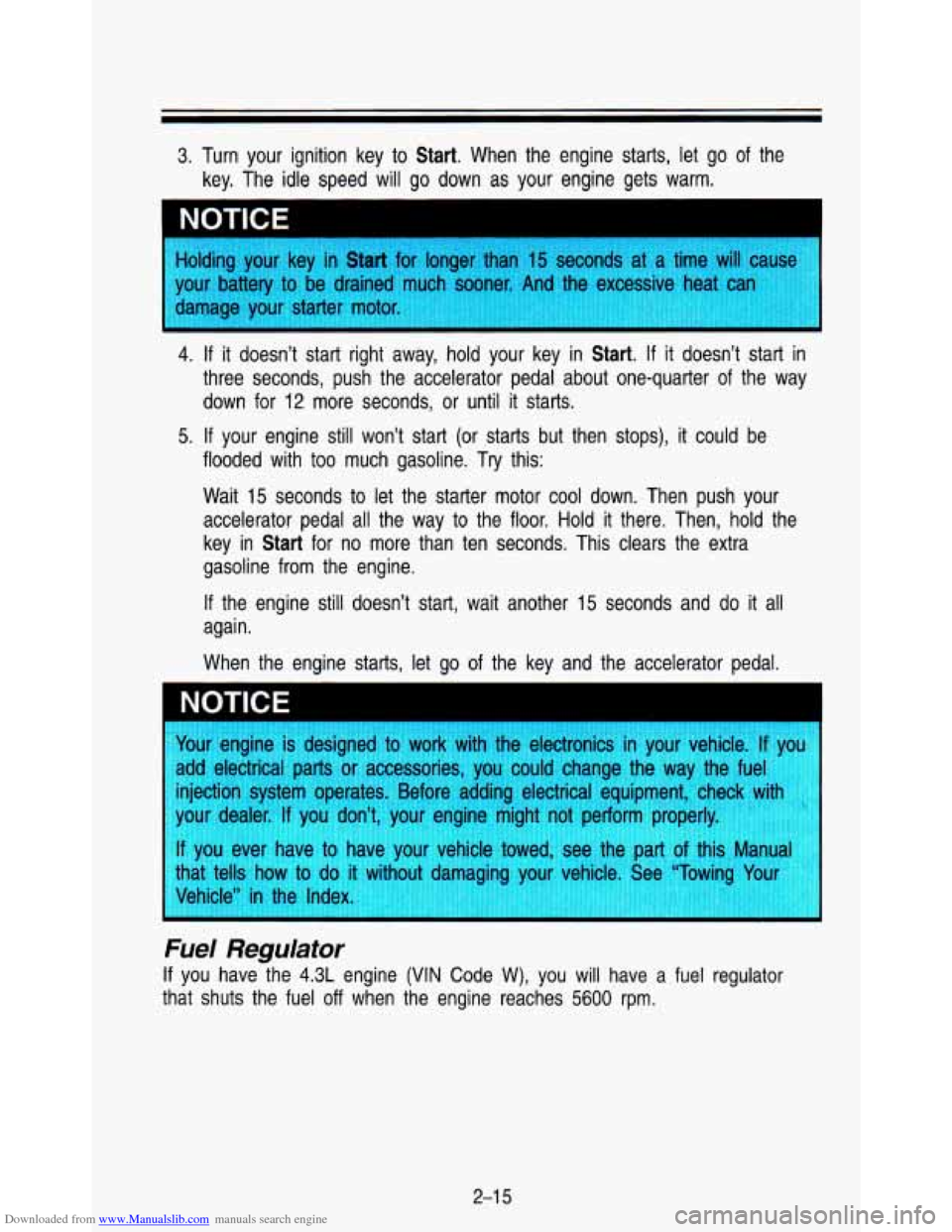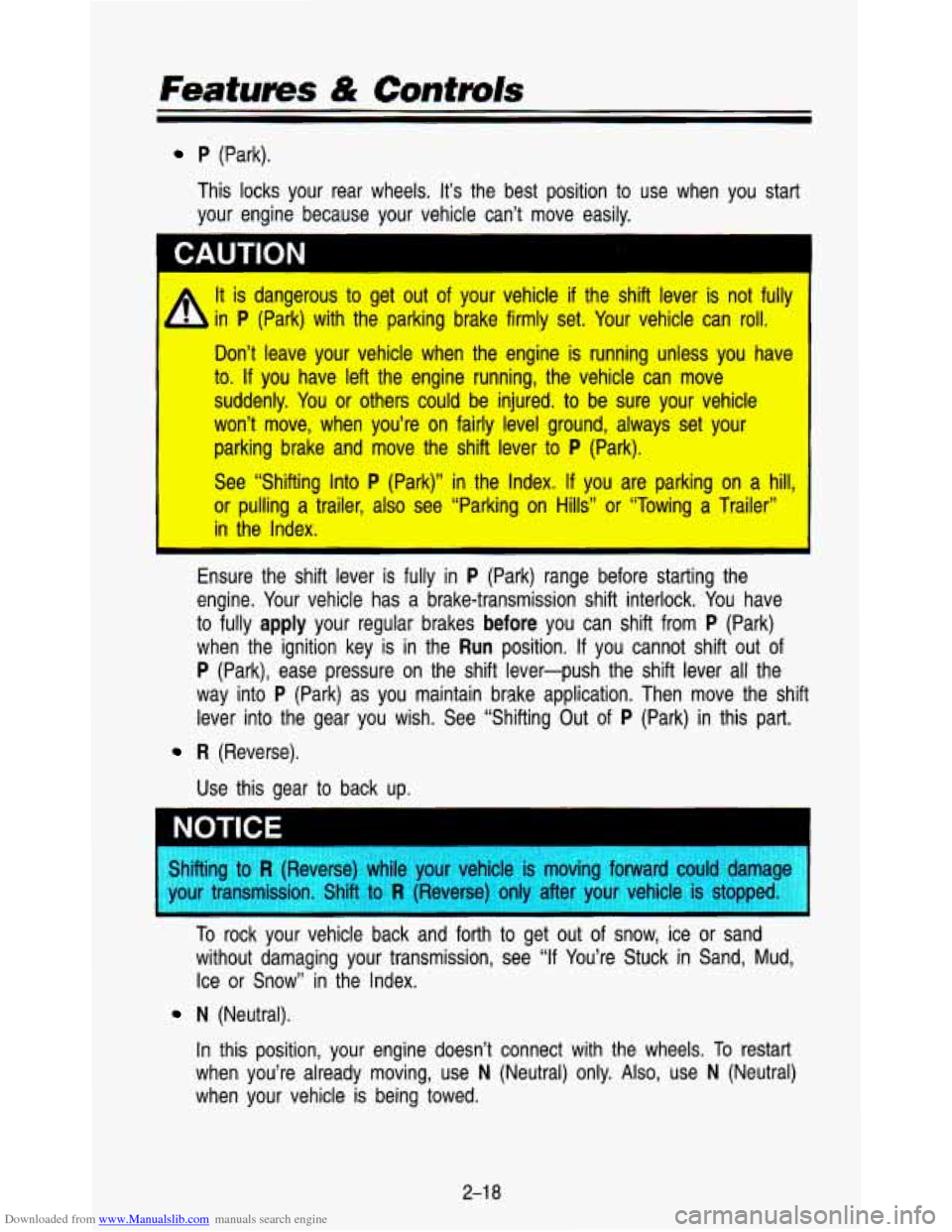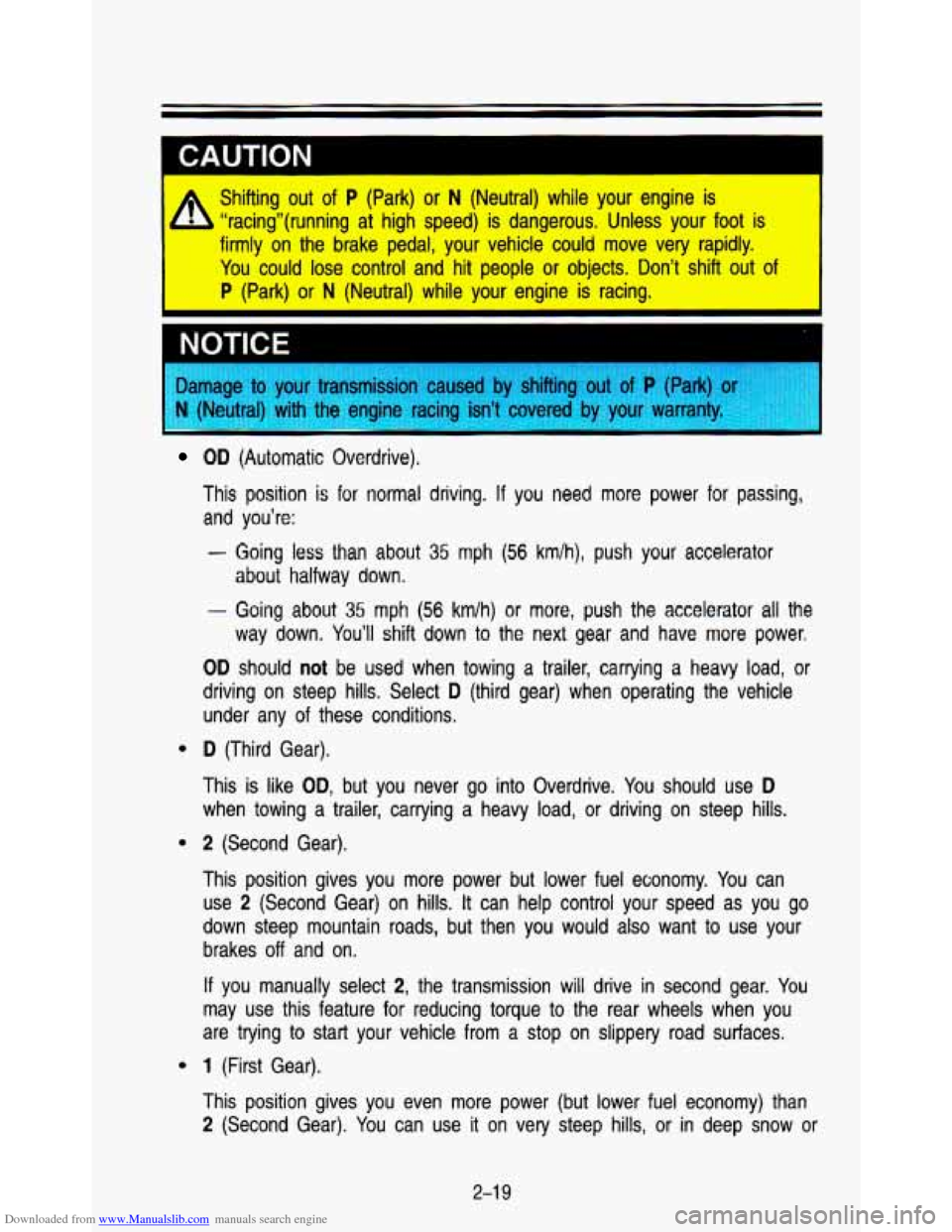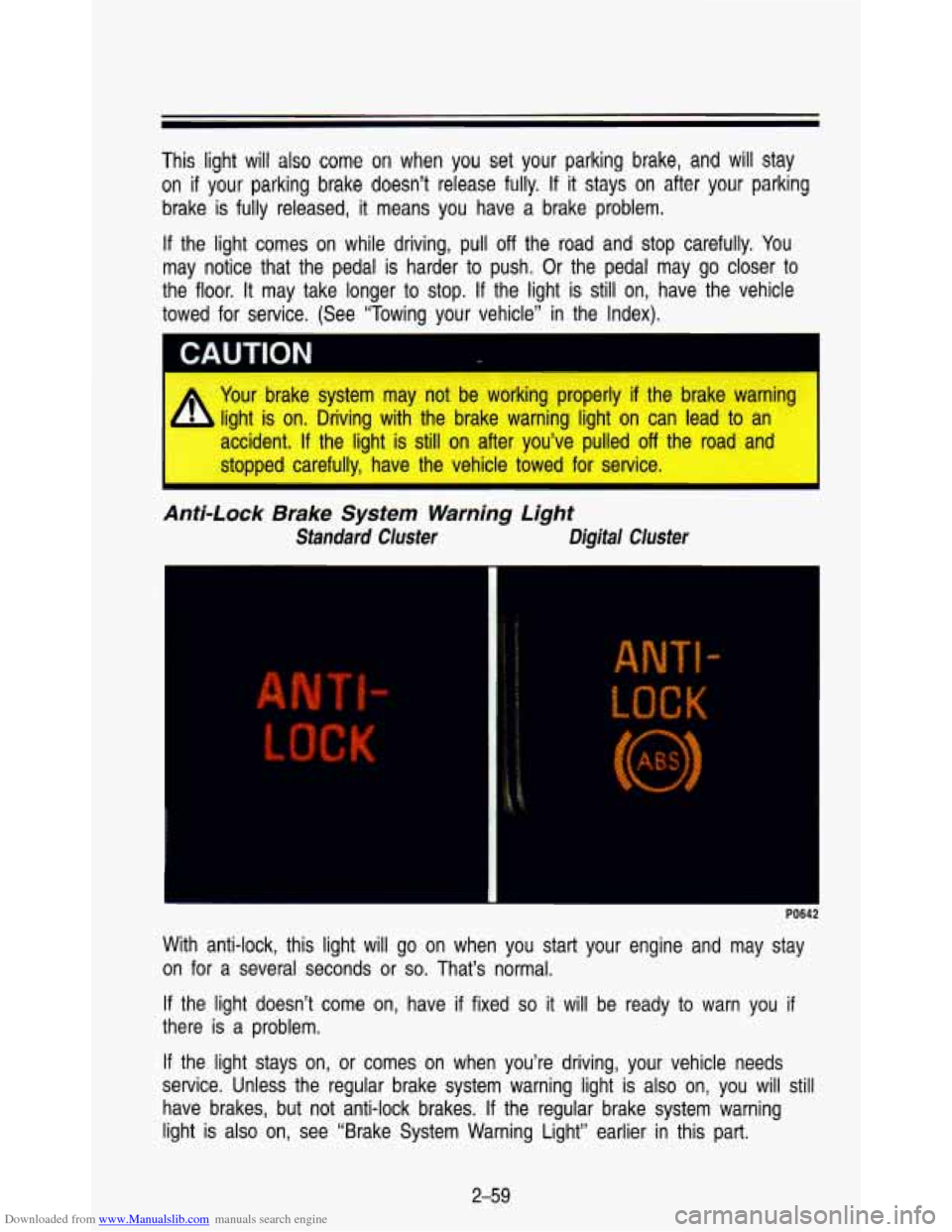1993 CHEVROLET ASTRO PASSENGER stop start
[x] Cancel search: stop startPage 71 of 345

Downloaded from www.Manualslib.com manuals search engine 3. Turn your ignition key to Start. When the engine starts, let go of the
key. The idle speed will go down as your engine gets warm.
NOTICE
Holding your key in Start for longer than 15 seconds at a time will car-
your battery to be drained
---? s~-~~~ And the e:*-?ssive heat ---
damage your starter motor
I
4. If it doesn’t start right away, hold your key in atart. If it doesn’t start in
three seconds, push the accelerator pedal about one-quarter of the way
down for
12 more seconds, or until it starts.
flooded with too much gasoline. Try this:
Wait
15 seconds to let the starter motor cool down. Then push your
accelerator pedal all the way to the floor. Hold it there. Then, hold the
key in
Start for no more than ten seconds. This clears the extra
gasoline from the engine.
5. If your engine still won’t start (or starts but then stops), \
it could be
If the engine still doesn’t start, wait another
15 seconds and do it all
again.
When the engine starts, let go
of the key and the accelerator pedal.
~ NOTICE
Your engine is designed to work with the electronics in your vehicle. If yo
add electrical parts or accessories, you could change the way the fuel
injection svstem operates. Before adding electrical equipment, ch\
eck with
vour
dt If you -.m’t, you. -ngi might not 1 -.form I perlv.
IT you ever have to have your vehicle towe see tl pan of tnrs Man[
that tells how to do it without damaging your ‘We.
e “Towing You
Vehi
’ ” ‘7 the Inc’ .
Fuel Regulator
If you have the 4.3L engine (VIN Code W), you will have a fuel regulator
that shuts the fuel
off when the engine reaches 5600 rpm.
2-1 5
Page 74 of 345

Downloaded from www.Manualslib.com manuals search engine P (Park).
This locks your rear wheels.
It’s the best position to use when you start
your engine because your vehicle can’t move easily.
WTION
It is dangerous to get out of your vehicle if the shift lever is not -fully
in
P (Park) with the parking brake firmly set. Your vehicle can roll. .
Don’t leave your vehicle when the engine is running unless you have
to.
If you have left the engine running, the vehicle can move
suddenly. You
or others could be injured. to be sure your vehicle
won’t move, when you’re on fairly level ground, always set your
parking brake and move the shift lever
to P (Park).
See “Shifting Into
P (Park)” in the Index. If you are parking on a hill:
or pulling a trailer, also see “Parking on Hills” or “Towing a Trailer”
in the Index.
Ensure the shift lever is fully in
P (Park) range before starting the
engine. Your vehicle has a brake-transmission shift interlock. You have
to fully
apply your regular brakes before you can shift from P (Park)
when the ignition key is in the
Run position. If you cannot shift out of
P (Park), ease pressure on the shift lever-push the shift lever\
all the
way into
P (Park) as you maintain brake application. Then move the shift\
lever into the gear you wish. See “Shifting Out of
P (Park) in this part.
R (Reverse).
Use this gear to back up.
I
Shifting to R (Reverse) while your vehicle is moving forward could dama--
your transmission. Shift
to R (Reverse) only after your vehicle is stoppec
To rock your vehicle back and forth to get out of snow, ice or sand
without damaging your transmission, see
“If You’re Stuck in Sand, Mud,
Ice or Snow” in the Index.
N (Neutral).
In this position, your engine doesn’t connect with the wheels.
To restart
when you’re already moving, use
N (Neutral) only. Also, use N (Neutral)
when your vehicle
is being towed.
2-1 8
Page 75 of 345

Downloaded from www.Manualslib.com manuals search engine CAUTION
Shifting out of P (Park) or N (Neutral) while your engine is
b “racing”(running at high speed) is dangerous. Unless your\
foot is
firmly on the brake pedal, your vehicle could move very rapidl\
y.
You could lose control and hit people or objects. Don’t shift out
of
P (Park) or N (Neutral) while your engine is racing.
NOTICE
sed by shifting out of P (Park) (
g isn’t covered I . .. . . . . . by . , . ..I. your , , , , warranty. , ., , ; s,L ., ... . , I . ::: :,.:. ’ .. ’., ; , : , .. . .: .. . , .. , , , . . . , .,
e
e
e
OD (Automatic Overdrive).
This position is for normal driving. If you need more power for passing,
and you’re:
- Going less than about 35 mph (56 km/h), push your accelerator
about halfway down,
- Going about 35 mph (56 km/h) or more, push the accelerator all the
way down. You’ll shift down to the next gear and have more power.
OD should not be used when towing a trailer, carrying a heavy load, or
driving on steep hills. Select
D (third gear) when operating the vehicle
under any of these conditions.
D (Third Gear).
This
is like OD, but you never go into Overdrive. You should use D
when towing a trailer, carrying a heavy load, or driving on steep hills.
2 (Second Gear).
This position gives you more power but lower fuel economy. You can
use
2 (Second Gear) on hills. It can help control your speed as you go
down steep mountain roads, but then you would also want to use your
brakes
off and on.
If you manually select 2, the transmission will drive in second gear. You
may use this feature
for reducing torque to the rear wheels when you
are trying to start your vehicle from
a stop on slippery road surfaces.
1 (First Gear).
This position gives you even more power (but lower fuel econo\
my) than
2 (Second Gear). You can use it on very steep hills, or in deep snow or
2-1 9
Page 88 of 345

Downloaded from www.Manualslib.com manuals search engine Windshield Wipers
PO478
You control the windshield wipers by turning the band marked WIPER.
For a single wiping cycle, turn the band to MIST. Hold it there until the
wipers start, then let go. The wipers will stop after one cyc\
le.
If you want
more cycles, hold the band on
MIST longer.
For steady wiping at low speed, turn the band away from you to the
LO
position. For high speed wiping, turn the band further, to HI. To stop the
wipers, move the band to
OFF.
‘ ~~~ CAUTION I
Damaged wiper blades may prevent you from seeing well enough to
drive safely. To avoid damage, be sure to clear ice and snow from
the wiper blades before using them.
If they’re frozen to the
windshield, carefully loosen or thaw them.
If your blades do become
damaged, get new blades or blade inserts.
I
A
Heaw snow or ice can overload your wipers. A circuit breaker will stop them
unt.. .he motor cools. Clear away snow
or ice to prevent an overload.
LOW Speed Delay Wipers
You can set the wiper speed for a long or short delay between wi\
pes. This
can be very useful in light rain or snow. Turn the band
to choose the delay
time. The closer
to LO, the shorter the delay.
2-32
Page 114 of 345

Downloaded from www.Manualslib.com manuals search engine Features & Contmls
Warning lights go on when there may be or is a problem with one of your
vehicle’s functions.
As you will see in the details on the next few pages,
some warning lights come on briefly when you turn the ignition\
key just to let
you know they’re working.
If you are familiar with this section, you should not
be alarmed when this happens.
Gages can indicate when there may be
or is a problem with one of your
vehicle’s functions. Often gages and warning lights work toge\
ther to let you
know when there’s
a problem with your vehicle.
When one
of the warning lights comes on and stays on when you are
driving, or when one
of the gages shows there may be a problem, check the
section that tells you what to
do about it. Please follow the manual’s advice.
Waiting to
do repairs can be costly-and even dangerous. So please get to
know your warning lights and gages. They’re
a big help.
Brake System Warning Light
Standard Cluster Digital Cluster
K E
Your
vehicle’s hydraulic brake system is divided into two parts. If one part
isn’t working, the other part can still work and stop you. \
For
good braking,
though, you need both parts working well.
If the warning light goes on, there could be a brake problem. Have your
brake system inspected right away.
This
light should come on as you start the vehicle. If it doesn’t come on
then, have
it fixed so it will be ready to warn you if there’s a problem.
2-58
Page 115 of 345

Downloaded from www.Manualslib.com manuals search engine This light will also come on when you set your parking brake, and will stay
on if your parking brake doesn’t release fully. If it stays on after your parking
brake is fully released, it means you have a .brake problem.
If the light comes on while driving, pull
off the road and stop carefully. You
may notice that the pedal is harder
to push. Or the pedal may go closer to
the floor. It may take longer to stop. If the light is still on, have the vehicle
towed for service. (See “Towing your vehicle” in the Index).
I
Your brake system may not be working properly if the brake warning
light is on. Driving with the brake warning light on can lead
to an
accident.
If the light is still on after you’ve pulled off the road and
stopped carefully, have the vehicle towed for service.
Anti-Lock Brake System Warning Light
Standard Cluster Digital Cluster
r
With anti-lock, this light will go on when you start your engine and may stay
on for a several seconds
or so. That’s normal.
If the light doesn’t come on, have
if fixed so it will be ready to warn you if
there is a problem.
If the light stays on, or comes on when you’re driving, your \
vehicle needs
service. Unless the regular brake system warning light is also \
on, you will
still
have brakes, but not anti-lock brakes. If the regular brake system warning
light is also on, see “Brake System Warning Light” earlie\
r in this part.
2-59
Page 141 of 345

Downloaded from www.Manualslib.com manuals search engine Seek Button
This chooses stations'also, but it doesn't keep moving as SCAN does. When
you push
SEEK, the radio goes to the next station .and stays there.
Clock
To set the clock, just:
1. Push
SET. (SET will be displayed.)
2. Within 5 seconds, push and hold SCAN until the correct hour appears.
3. Press and hold
SEEK until the correct minute appears.
To display the clock with the ignition off, push the upper knob. The time will
be displayed for a few seconds.
Cassette Tape Player
Your tape player is built to work best with tapes that are 30 to 45 minutes
long on each side. Tapes longer than that are
so thin they may not work well
in this player.
To play a cassette tape:
Have the radio on.
Insert the tape squarely through the tape door.
The longer side with the tape visible goes in first. If you hear nothing or hear
just garbled sound,
it may not be in squarely. Push STOP-EJECT to remove
the tape and start over.
Once the tape is playing, use the upper and lower knobs for \
volume and balance, just as you do for radio. The arrows show which side\
of the tape is
playing.
To go forward to another part of the tape, push the button with an
arrow pointing toward the lighted arrow.
To go backward, push the button with an arrow pointing away from the
lighted arrow. To stop the tape, push the
STOPEJECT button lightly.
To go from one side of the tape to the other, push in the upper knob
To remove or stop the tape, push STOP-EJECT.
on your radio.
Press
STOP-EJECT lightly to stop the cassette. Push STOP-EJECT again to
remove the cassette and start the radio.
3-1
7
Page 145 of 345

Downloaded from www.Manualslib.com manuals search engine Cassette Tape Player
Your tape player is built to work best with tapes that are 30 to 45 minutes
long on each side. Tapes longer than that are
so thin they might not work
well in this player.
To play a cassette tape:
Have the radio on.
Insert the tape squarely through the tape door.
The longer side with the tape visible goes in first. If you hear nothing or hear
just garbled sound,
it may not be in squarely.
Push
EJECT to remove the tape and start over.
Once the tape is playing, use the upper and lower knobs for volume
and balance, just as you
do for the radio. The arrows show which side
of the tape is playing.
To go forward to another part of the tape, push FWD.
To go backward, push REV. To stop the tape push the other button
To go from one side of the tape to the other, push in the upper knob
The
SEARCH button lets you play a selection again, or skip ahead to the
next selection. lightly.
on your radio. To remove or stop the tape, push
EJECT.
To play the selection again:
Push SEARCH button to the right. (The ON light will come on.)
Push REV to go back to the beginning of the selection that is playing.
To play the next selection:
Push SEARCH button to the right. (The ON light will come on.)
Push FWD. The tape will go to the next selection.
Press
EJECT to remove the cassette and start the radio.
3-21